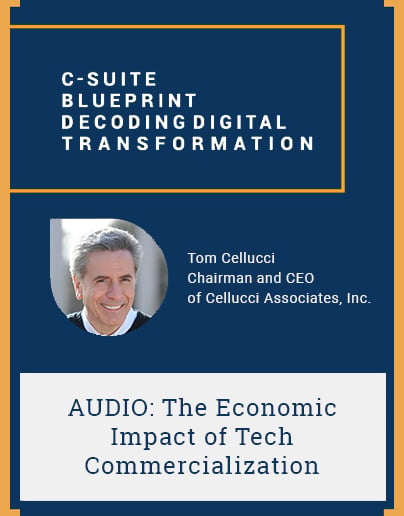C-Suite BluePrint: Decoding Digital Transformation
Tech commercialization is the engine that powers the wheels of progress.
Invention, innovation, and commercialization are all fundamental pieces in the tech development process.
However, Tom Cellucci, Chairman and CEO of Cellucci Associates, Inc., believes it’s commercialization that ultimately drives technology's global impact on the quality of life for nations and their people.
Tom talked with us about:
- How both public and private sectors influence tech commercialization
- Exciting new tech progressing because of commercialization
- Why the U.S. leads in invention but is falling behind in commercialization
Potential in Public-Private Partnerships
“This concept of innovative public-private partnership where the taxpayer wins, the government wins, and the private sector wins is a no-lose.”— Tom Cellucci
In 2007, President Bush appointed Tom Celluci as the first-ever Chief Commercialization Officer in a U.S. executive agency. So, Tom has a strong opinion on tech commercialization.
“It’s great to invent… to have one real application,” he said. “But it’s the mass commercialization of something that brings prosperity to a region, an area, a country.”
Highlighting the importance of tech commercialization - the marketing and production stage of the creative process - is not a new notion.
In 1990, this Harvard Business Review article painted a prophetic picture of the impending necessity for pioneers to match their commercialization power with their innovation:
"“Just as quality and manufacturing excellence were key to competitiveness in the 1980s, superior commercialization of technology will be crucial in the 1990s. In the coming decade, businesses will rise and fall depending on whether they discipline their commercialization efforts.” —Tom Cellucci
Indeed, a slew of private enterprises have risen and fallen during this technological golden age. But another player in the tech race has stepped up to the challenge of advancing tech commercialization efforts: the public sector.
With Tom’s appointment as CCO, the White House showed its continuing commitment to enabling technological development.
Many Americans likely remain oblivious to how much incredible technology they owe to initiatives launched or funded by government agencies. Doppler radar, MRIs, microchips, barcodes, and - yes - a multitude of vaccines exist primarily due to the public sector.
Tom stressed the influence that officials in scientific agencies have on technological development across the board.
“If you have people in your audience who think everyone’s just there pushing a button in government - you have the ability to change things,” Tom said.
Tom used his influence for change by working with private companies to commercialize tech that his colleagues in the public sector brought to the table.
“I was able to get the private sector to use their resources, their time,” he said. “I would put out detailed operational requirements and estimated the potential, and they would come back with a solution… all at their cost.”
And because of tech commercialization efforts like these, the next wave of exciting new technology is right around the corner.
Nanotechnology and a Future with Fusion
Invention and innovation bring compelling vision to the scientific field. But tech commercialization injects the biggest mover of all into R&D - and that’s money.
Thanks to commercial opportunities, revolutionary ideas like nanotechnology are becoming a reality.
As the world prepares for new COVID strains and with cancer cases skyrocketing, public and private medical institutions are turning to nanotech.
“I’m with a younger company doing nanotechnology,” Tom told us. “And they are now working on phenomenal capabilities in terms of nano-based solutions.”
Tom agrees with others’ findings that nanotech may be the future of alternative medical treatment for fighting new disease strains.
“One thing COVID taught us is that we weren’t prepared in terms of disinfection and keeping ourselves safe,” he said.
Tom is also excited about lab breakthroughs in fusion energy research, citing progress at the National Ignition Facility in Livermore, California.
“What they’re doing is using a whole series of laser beams to impinge a pellet, if you will, to create this fusion reaction,” he explained. “And the world’s very interested.”
His security clearance inhibited him from elaborating, but Tom assured us that he’s working with movers and shakers to help make marketable fusion energy a reality.
“We’re speaking with a lot of people - in our government, the department of energy, the White House - to try to get this moving,” he said. “Because that would be a terrific commercialization project for our nation.”
Tech Commercialization on the World Stage
With so many groundbreaking initiatives on American soil, surely the U.S. is primed to make waves in tech commercialization?
Tom argues that, unfortunately, that is not the case.
“We don't have the corner market anymore in the United States on commercialization,” he said.
Tom believes the U.S. is still a leader in technological inventions, but we’re playing catch up in the commercial sector. He cited the semiconductor, automotive, and advanced manufacturing industries as areas in which other countries are pulling ahead.
“There are countries that have taken and looked at those inventions and got applications or innovations first, which then enabled them quickly to go to commercialization,” Tom said. “Which, again, talks about market segments and monetizing this technology.”
He also thinks that tech commercialization is a missed opportunity in this time of economic uncertainty.
“We have a lot of debt in this country, and we need to generate money for our country and our people,” Tom stated.
Failing Upward Together
Tech commercialization may be the heart of technological development, but regardless of someone’s role in scientific advancement, Tom takes failure in stride.
After all, if our tech pioneers aren’t taking chances, what’s the point of invention and innovation?
“Show me a person who makes mistakes, and I’ll show you a person who tries things,” he said. “Making mistakes tells me you can take risks. That’s important in life and business.”
Would you like to hear more? You can find this interview and many more by subscribing to C-Suite Blueprint on Apple Podcasts, on Spotify, or here.
